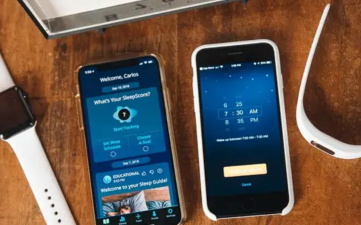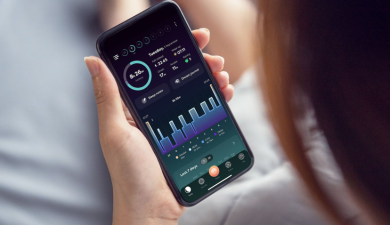In life, there are many people who always can't sleep or sleep well at night. The reasons are also varied, such as emotional influence, disease troubles, snoring of the pillow... Now there are many apps for managing sleep, monitoring breathing rhythm, heartbeat pulse, and even recording rapid eye movement period, deep sleep time, and scoring sleep quality.
In life, there are many people who always can't sleep or sleep well at night. The reasons are also varied, such as emotional influence, disease troubles, snoring of the pillow...
Now there are many apps for managing sleep, monitoring breathing rhythm, heartbeat pulse, and even recording rapid eye movement period, deep sleep time, and scoring sleep quality.
Principle of sleep detection:
Previously, the sleep detector needed to be in contact with the body, through sensors such as turning over, etc., and now the mobile phone software is roughly the same. According to the state of mobile phone use, the light of the mobile phone changes, the sensor set in the mobile phone collects the movement amplitude of the body during sleep, etc., so this requires that the mobile phone cannot be too far away when sleeping, otherwise the detection is meaningless, which is why it was required to be carried with you in the early years.
However, many people will have doubts about the process of using it. That is, is my data accurate, and what kind of help does it have for my sleep.

In fact, these tools can give certain suggestions on sleep time, but the depth of sleep and sleep quality are not accurate, and it is difficult for these apps to detect the short-term awake state during sleep.
Generally speaking, the body will have different reactions in different stages of sleep. For example, REM sleep involves less muscle activity and movement than non-REM sleep, and people naturally move more when awake than when asleep. So whether it's measuring body movement using a device's microphone to record the sound of movement, or using an accelerometer to detect changes in the device's position, it's possible to infer whether a person is sleeping.
But how strong is the relationship between body movement and sleep quality? Many people who have trouble falling asleep are relatively still in bed, so how does a device know they're awake? In short, devices can't actually measure accurately, and the sleep data we get is bound to have some errors.
Limitations of sleep tracking apps
Studies have compared sleep tracking apps to scientifically validated sleep monitoring methods. In a 2015 study of 65 adolescents, researchers compared data from wristband sleep trackers to data from polysomnography. Polysomnography records brain activity readings, muscle recordings, and eye movements, while commercial sleep trackers use accelerometers to record movement data.
The only sleep measurement that was relatively the same in both methods was the time it took people to fall asleep after getting into bed. Some sleep trackers on the market overestimate total sleep time and underestimate total wake time compared to what a polysomnogram records. However, the average difference between each sleep tracker was only about 10 minutes.
The data was less accurate when it came to identifying different stages of sleep. Although sleep trackers can track "light sleep" and "deep sleep," the data displayed by the tracker and the data shown by the polysomnogram did not match.
For example, the same period of sleep may be recorded as light sleep by a sleep tracker, but deep sleep on a polysomnogram.
A 2018 paper combined the results of experiments on 11 different sleep tracking apps to reach a consensus on their effectiveness. The conclusions were consistent with the above studies. Most smartphone apps can distinguish between sleep and wake stages during the night, but there is a tendency to overestimate sleep time. But the mobile apps did not do a good job of distinguishing between light sleep and deep sleep, two different sleep stages, and the polysomnogram did not confirm the data they presented.
The only products that do relatively well use external sensors to record heart rate and breathing rate in addition to the accelerometers that record body movement. It’s unclear how much heart rate and breathing rate readings improve sleep-tracking apps’ detection of sleep stages, but some evidence does suggest that heart rate is actually related to sleep stages. This is good news for wearable sleep trackers that include heart rate data.
Another problem with sleep trackers is that it’s hard to measure the reliability of a particular model. Companies tend to avoid sharing proprietary information such as sensor accuracy or data quality. So even if the overall evidence shows that accelerometer and heart rate technology is feasible for basic sleep tracking, individual products may not meet the minimum standards for collecting sleep data. Just as importantly, the evidence itself is limited: most existing studies comparing sleep trackers to polysomnography used volunteers with healthy sleep patterns, not those who lack healthy sleep patterns.
For some people, sleep trackers can be very effective. However, sleep trackers may be least effective for those who have poor sleep quality, and they are precisely the people who need this technology the most. When devices can't reliably detect wake-up times, users whose sleep is most interrupted naturally don't get the most accurate readings because they wake up the most frequently.
A 2018 statement from the American Academy of Sleep Medicine said these sleep-tracking apps can't yet be used to diagnose or treat sleep problems. For now, it should be limited to providing additional data support during a more comprehensive evaluation with a health professional.

The potential for sleep tracking apps
In June 2019, researchers from around the world who study sleep gave a preliminary presentation of their newfound sleep technology at the annual United Professional Sleep Societies conference. Some studies also reaffirmed that sleep trackers have a hard time detecting wake-up times. But some projects have also addressed the issue of improving sleep quality. Researchers using cognitive behavioral therapy to treat insomnia have found that they can use an app to track sleep remotely to reduce the burden of in-person visits from volunteers when analyzing progress. In another small-scale pilot study, it was found that proper sleep coaching used with a wearable tracker can help reduce sleep disturbances.
Therefore, sleep tracking apps can be a practical tool for treatment. While we need to wait until this data is published before we can draw firm conclusions, it is important to understand the correlation between sleep trackers and sleep problems that are currently being studied in academia.
Based on the evidence so far, some of the sleep trackers on the market clearly have potential. Their widespread and regular use means that researchers can easily collect real data about sleep quality from a large number of people, which can help clinicians better understand why so many people have sleep problems and how to improve their sleep.
For those who currently use trackers at home, sleep trackers may increase awareness of poor sleep habits and inspire people to improve their sleep. Obviously, sleep is important to human health, so products that encourage people to pay attention to sleep quality may have some benefits. But for those who already take their sleep habits seriously, whether they stick to their own regular bedtime or use other methods, it is not yet clear that sleep trackers can help them. There is no doubt that this technology will improve and the scientific community will support sleep trackers. However, users who hope to improve their sleep quality should be cautious when interpreting the data, and everyone should be skeptical of the data related to light sleep and deep sleep given by the tracker.

